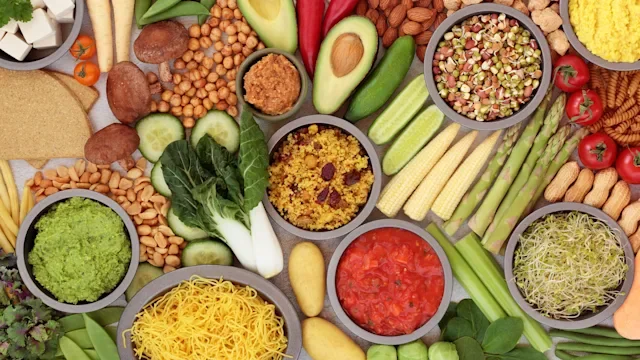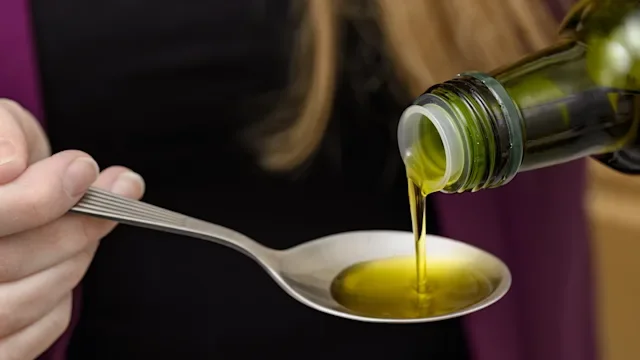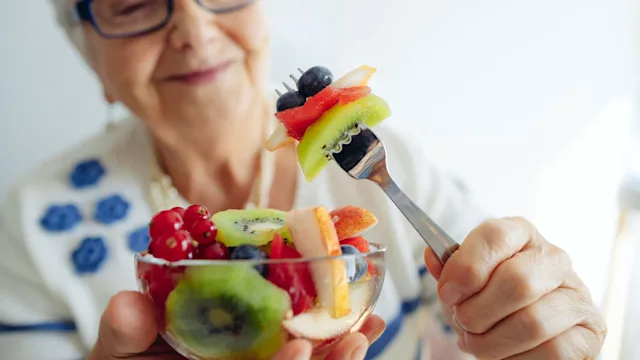Key takeaways:
Water retention happens when the body holds onto more water than it gets rid of. Water retention can be a sign of kidney or heart conditions.
Some signs of water retention include swelling in the feet or ankles, belly bloat, or sudden unexpected weight gain.
Foods that are high in sodium (salt), sugar, and alcoholic drinks can worsen water retention.
The amount of water going in and out of the body is normally kept in strict balance. When you’re dehydrated, you feel thirsty — it’s the body’s signal that it’s time to drink more water. And if you need to get rid of extra fluid, you pee more often.
But from time to time, you may notice that you’re retaining water. Usually this shows up as swelling in the feet or ankles or mild belly bloat that goes away throughout the day. Some people may also notice swelling in their hands or unexplained weight gain.
Why does water retention happen? In some cases, it can be a sign of a medical condition like kidney or heart disease. Some medications can cause water retention, too. But certain foods can also trigger water retention. These foods can also worsen water retention if you already experience water retention from a medical condition or a medication. Here are six foods that can worsen water retention.
1. Salty snacks
Salty snacks can trigger water retention. These include:
Any kind of chips
Pretzels
Popcorn with salt added
Salted nuts
Salty foods can lead to water retention because water follows salt. This means that in order to maintain the right level of hydration to your tissues, your body will hold on to more water to balance out any extra salt you eat.
Medications can cause water retention, too. Find out if your medications could be contributing to water retention.
Have more questions about ultra-processed foods? Learn more about how to identify ultra-processed foods and how they can affect your health.
Need tips on choosing foods that stop water retention? Take a look at these types of ancient grains and how to add them to your diet.
2. Processed foods
Some foods clearly have a lot of extra salt — like salt and vinegar chips. But other foods are packed with sodium even though they don’t taste particularly salty. That’s the problem with processed foods like:
Frozen meals
Canned soups
Deli meats
Processed meats like bacon and prosciutto
These foods are packed with hidden salt, which can trigger water retention. It’s a good idea to check nutrition labels to see how much sodium these products contain. Experts recommend that most people eat less than 2,300 mg sodium per day. This number may be even lower for people with certain health conditions. Just one serving of some of these products can contain your total sodium allotment for the day.
3. Restaurant-prepared foods
Restaurants can add a lot of salt to their food to help make it taste better. In some places, restaurants are required to provide information about a meal’s sodium content. But often, there’s no way to know how much salt is in restaurant-prepared food. Your meal could contain more than your recommended daily salt intake.
Limiting how often you eat out can help lower your overall salt intake. Studies show that food that you make at home tends to have less salt than the same food made at a restaurant.
Read more like this
Explore these related articles, suggested for readers like you.
4. Alcohol
Alcohol affects water balance in the body in two ways. In the short term, it can act as a diuretic and make you pee more.
But long-term alcohol abuse disorder and heavy alcohol use, like binge drinking, can actually cause water retention. That’s why some people wake up after a night of drinking feeling “puffy” or bloated.
But keep in mind that any type of alcohol can trigger water retention, even if it has a lower alcohol content. This includes:
Beer
Wine
Distilled spirits
And there are two additional reasons drinking alcohol might trigger water retention. First, some mixed drinks can contain salty ingredients. Second, many people tend to eat more when they’ve been drinking alcohol. So you might be more likely to reach for a salty snack or order more food if you’re at a restaurant. Research suggests that this has to do with how alcohol affects the brain.
5. Sugary treats
If you have more of a sweet tooth, you’re still not off the hook. Sugary treats can also cause water retention.
You may know that sweet treats increase blood sugar. When your blood sugar goes up, your body releases insulin. High insulin levels make you retain more salt and water.
And your body releases even more insulin when you eat food that causes your blood sugar to spike. If you’re dealing with water retention, you may find it helpful to try limiting sugary treats like:
Cakes
Cookies
Soda
Fruit drinks
Sports drinks
Again, try checking nutrition labels. This can give you a sense of how much added sugar your favorite treats contain.
How much sugar is too much? The American Heart Association (AHA) recommends that most people limit their added sugar intake to 25 g to 36 g per day. You may have to limit your sugar intake even more if you have certain medical conditions, like diabetes.
6. Refined carbohydrates
Just like there’s “hidden salt” in processed foods, there are also “hidden sugars.” Refined carbohydrates are a perfect example of foods that contain hidden sugars. They don’t taste very sweet, but they can cause rapid increases in your blood sugar levels.
Refined carbohydrates are processed in a way that removes most of the nutritional value of the grain. These types of carbohydrates are quickly broken down into sugar in the body and cause insulin levels to go up. This in turn causes water retention. Examples of refined grains include:
White rice
White bread
White flour
Foods made with and from these items can also cause water retention.
Tips to reduce water retention
Here are some tips that can help you avoid or reduce water retention.
Stick to a low-salt diet
Following a low-sodium diet can help reduce water retention. For most people, this usually means eating less than 2,000 mg of sodium each day. Try to incorporate more fruits and vegetables in your diet and limit processed foods. Fresh fruits and vegetables are naturally low in sodium and have no added sugars.
Check nutrition labels for sodium content per serving so you don’t eat too many salty foods. It can also help to write down your sodium intake or use an app that helps you keep track. This way you’ll know when you’re reaching your daily limit.
Prepare meals at home
Restaurant-prepared meals are more likely to cause fluid retention than food you cook at home. That’s because when you eat out, food generally has more salt and sugar — both of which can cause fluid retention. Cooking at home can help you avoid this extra salt and sugar. Meal prepping can help make cooking less stressful and time consuming.
Avoid alcohol
There are many health benefits to drinking less alcohol, including better heart and liver health. One early change you may notice is weight loss and less “puffiness.” Stick to nonalcoholic beverages to reduce water retention.
Pick whole grains
Refined carbohydrates can cause water retention. Opt for whole grains when you can. These grains are digested more slowly in the body and don’t trigger an insulin surge. This means whole grains are less likely to cause water retention. You can find whole-grain breads and bakery products in most stores. You can also swap white rice, pasta, and white flour for whole-grain options.
When should you see a healthcare professional about water retention?
Usually, mild fluid retention will resolve on its own. But swelling that doesn’t go away or gets worse over time can be a sign of a more serious health condition. See your primary care provider if you’re noticing that you’re experiencing water retention most days. You also want to get care if that water retention doesn’t seem to get better throughout the day. Usually, signs of water retention are worse first thing in the morning but get better throughout the day.
People with heart, kidney, and liver disease are more likely to retain water, called edema. In these cases, swelling may start in the feet or ankles but then progress up the legs. Extra fluid can also build up in the abdomen, called ascites. Or around the lungs, called pulmonary edema. In these cases water retention is more serious. It can cause abdominal discomfort and shortness of breath. Reach out to your healthcare professional right away if you notice any of these symptoms.
The bottom line
Mild swelling in the feet that resolves on its own is not a cause for concern. Avoiding food and drinks that cause water retention may solve the problem. Pay particular attention to how much salt you’re eating. Try to limit foods that are high in sodium like salty snacks, processed foods, and restaurant-prepared meals.
But if you have persistent swelling, fluid accumulation in the belly, or shortness of breath, see your healthcare professional. It may be a sign of a more serious condition.

Why trust our experts?


References
American Heart Association. (n.d.). How much sugar is too much?
American Heart Association. (2022). Effects of excess sodium infographic.
American Heart Association. (2023). Carbohydrates.
American Heart Association. (2023). Sodium sources: Where does all that sodium come from?
Anekwe, A. V., et al. (2019). New York City’s sodium warning regulation: From conception to enforcement. American Journal of Public Health.
Centers for Disease Control and Prevention. (2022). Insulin resistance and diabetes.
Christiansen, P., et al. (2016). Alcohol’s acute effect on food intake is mediated by inhibitory control impairments. Health Psychology.
DiNicolantonio, J. J. (2022). Added sugars drive insulin resistance, hyperinsulinemia, hypertension, Type 2 diabetes and coronary heart disease. Missouri Medicine.
Higdon, J. (2019). Sodium (chloride). Linus Pauling Institute, Oregon State University.
Malek, R., et al. (2023). Pulmonary edema. StatPearls.
Taivainen, H., et al. (1995). Role of plasma vasopressin in changes of water balance accompanying acute alcohol intoxication. Alcohol: Clinical and Experimental Research.
U.S. Department of Agriculture. (2014). Foods prepared at home are less sodium dense than those from restaurants, but still above guidelines.
U.S. Food and Drug Administration. (2024). Sodium in your diet.
Vamvakas, S., et al. (1998). Alcohol abuse: Potential role in electrolyte disturbances and kidney diseases. Clinical Nephrology.


















